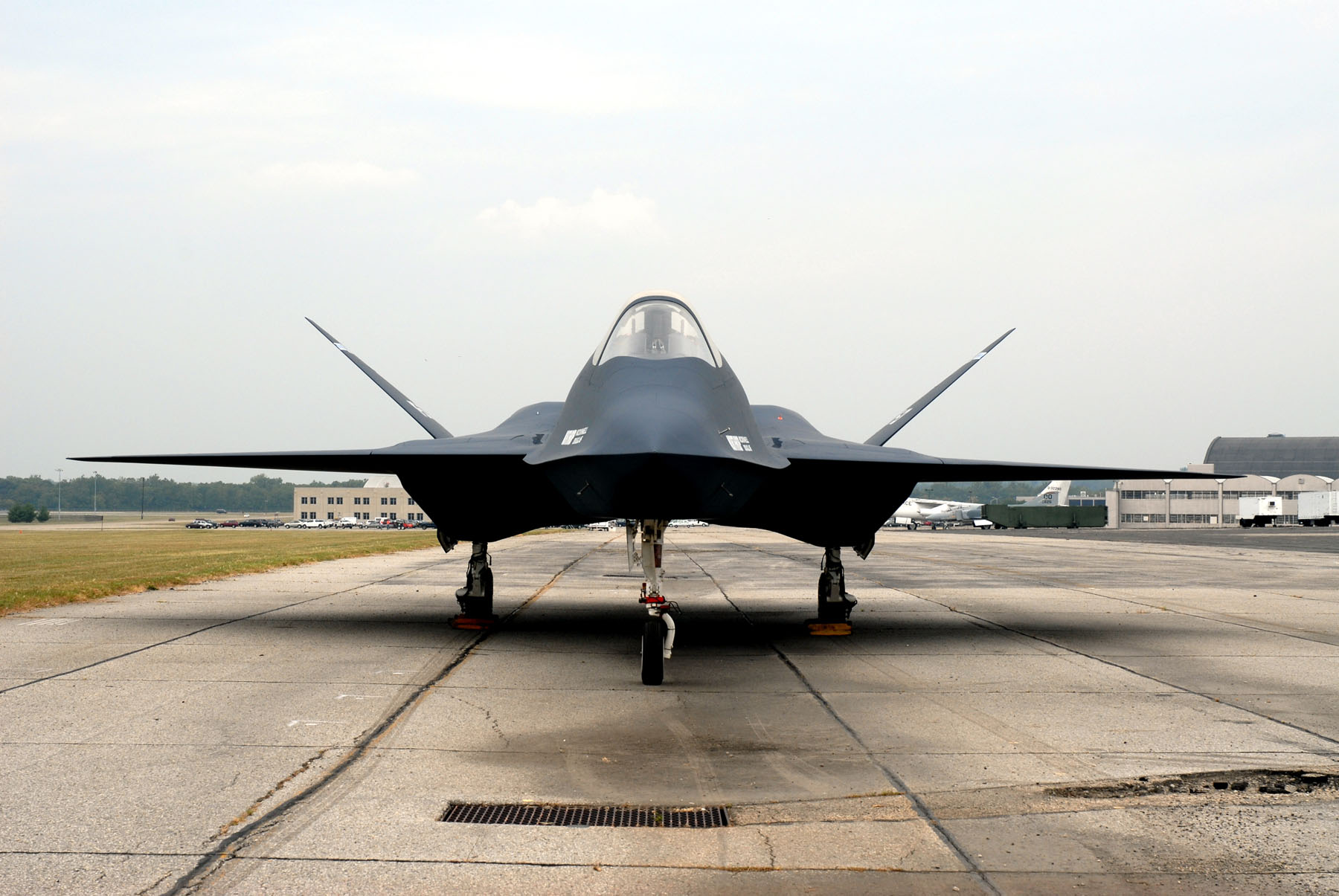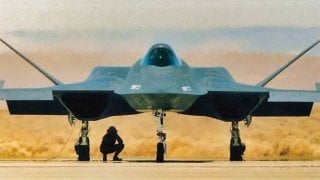YF-23: The Stealth Fighter The Air Force Missed Out On (Mistake?)
Both Northrop’s YF-23 and Lockheed’s YF-22 were clearly extremely capable fighters. Northrop’s YF-23 offered greater range and superior stealth, but the YF-22 used more advanced avionics and had a slight advantage in maneuverability.
In the decade and a half since it first entered service, the Lockheed Martin F-22 Raptor has been an air superiority fighter without equal, but that hasn’t always been the case. For a short time in the 1990s, the YF-22 that would lead to the operational F-22 may have met its match in the form of Northrop’s YF-23. Either of these highly capable airframes would have resulted in a dominant air superiority fighter that would be the first of a new generation, and the truth is, performance may not have even been the ultimate deciding factor between these two jets. Perception is everything, even in the airplane business.
A new fighter for an old war
In the 1980s, the United States Air Force started hunting for a new kind of fighter that could dominate the latest generation of Soviet jets like the Su-27 and Mig-29. While the Soviet Union was less than a decade away from collapse, their fighters were highly capable fourth-generation platforms developed specifically to counter America’s premier fighters, the air superiority F-15 Eagle and the multi-purpose F-16 Fighting Falcon.
Rather than continuing to develop ever-more-powerful and higher flying fighters as had been the norm throughout much of the Cold War, the Air Force wanted to incorporate a newer and uniquely American capability into their next-generation fighter: stealth. Among their other requirements was the ability to “supercruise” or maintain supersonic speeds without using the aircraft’s afterburners. Super cruising would mean this new fighter would be able to close with enemy jets at a high rate of speed without sacrificing much in the way of fuel — ensuring the new fighter would have plenty of fight left in it after a long haul to the battlespace. The Air Force intended to order 750 of the winning fighter to replace the F-15 Eagle as America’s first line of defense against inbound Soviet bombers and fighters.
By the end of 1986, two teams were chosen to develop their next-generation fighter concepts: Northrop teamed up with McDonnell Douglas, and Lockheed, Boeing, and General Dynamics assembled their opposition. Both Lockheed and Northrop had experience in developing stealth platforms for the U.S. Air Force. Lockheed had been responsible for the world’s first operational stealth aircraft, the F-117 Nighthawk. Northrop had lost out to Lockheed in the competition for that contract, but continued working on their stealth concept until it matured into the B-2 Spirit, which remains in service to this day.
Speed, stealth, and maneuverability
While the F-22 Raptor bears a passing resemblance to conventional 4th generation fighters despite its stealth design, the YF-23 was rather unconventional. Like the F-22, it utilized diamond-shaped wings to reduce its radar signature, but the two diverged dramatically in the nose and tail sections. The YF-23’s nose is striking, with its cockpit pushed forward on the airframe for improved visibility and a drooping duckbill of a nose adding to the platform’s alien aesthetic. On the back, an all-moving V-tail gave the fighter incredible maneuverability despite the platform lacking in the F-22’s thrust vectoring capabilities.
Two YF-23 prototypes were ultimately built. The first, dubbed the Black Widow II by those involved with the program, was all black and powered by a pair of Pratt & Whitney engines that allowed the jet to supercruise at Mach 1.43 during its first round of testing in 1990. The second YF-23, painted grey and dubbed “Grey Ghost,” switched to General Electric YF120 engines, which offered improved supercruise capabilities, reaching Mach 1.6 in testing, just slipping past the YF-22’s Mach 1.58.
While the YF-23’s top speed remains classified to this day, defense analysts have claimed that it was better than Mach 2. However, the operational F-22 flying today beats both of those marks, with a top speed of Mach 2.25 and the ability to supercruise at Mach 1.82.

The YF-23 proved to be stealthier than its competitor, though it was seen as less maneuverable than the thrust-vectoring YF-22. Thrust vector control allows the pilot to aim the outlet of the jet’s thrust to dramatically increase maneuverability, even allowing the aircraft to continue flying in one direction as it points its nose in another. Northrop opted not to include thrust vector control in their YF-23 in favor of a stealthier radar profile and lighter overall platform. Instead, they used the large surfaces of the YF-23’s unique V-tail to help the fighter turn on a dime — and the truth is, it managed performance that was nearly comparable to the F-22’s despite its lack of thrust vector control.
Ultimately, while the YF-23 could just about match the F-22’s acrobatics, Lockheed won the perception war by demonstrating their fighter’s capabilities in a more dynamic way. Lockheed test pilots showed off the aircraft’s ability to utilize a high angle of attack, fired missiles, and executed maneuvers that placed more than 9Gs worth of force on the airframe. While the YF-23 could have done the same, Northrop didn’t in the demonstration. Many contend that it was this salesmanship, rather than strictly platform capabilities, that helped the YF-22 stand out in the minds of defense officials.
The most notable place where the YF-23 had a clear advantage was in fuel range. Early in these aircraft’s development stage, the U.S. Navy had plans to adopt the winner as a replacement for their own aging fourth-generation intercept fighter, the F-14 Tomcat. The YF-23’s combat radius was significantly greater than the F-22s, which, when coupled with its slightly better stealth profile, meant the YF-23 could fly further into contested airspace (where refueling isn’t an option) than its Lockheed competitor. Today, that capability would be coveted among Navy officials, as the branch continues to work toward finding ways to extend the combat radius of carrier-borne fighters.
Brand perception is brand reality
Both Northrop’s YF-23 and Lockheed’s YF-22 were clearly extremely capable fighters. Northrop’s YF-23 offered greater range and superior stealth, but the YF-22 used more advanced avionics and had a slight advantage in maneuverability.
“We ended up with two aircraft, each one of which could meet the Air Force’s technical specifications and technical requirements.”
-Air Force Secretary Donald Rice upon awarding the contract to Lockheed.
To be clear, either option would have become a game-changing platform and the first of the 5th generation, but despite Northrop’s excellent aircraft, the company itself was seen as less capable, and even less trustworthy than Lockheed. For four years leading up to the competition, Northrop had faced repeated scrutiny and even serious allegations throughout their product line, leading to a series of congressional committee hearings and a number of Pentagon audits. Even if the Air Force wanted the YF-23 over the YF-22, they were aware that Northrop’s reputation would make the fighter a tough sell among lawmakers.
“If you are not able to execute a program without having problems and cost overruns, you are going to run into a buzz saw in Congress,” Paul Nisbet, an aerospace analyst at Prudential-Bache Securities, said at the time.
“Northrop has been under the gun for years. The Pentagon does not want to spend its political hay by running against the grain.”
That sentiment was echoed by statements from defense officials involved in the decision as well.
The thing I like about (the Lockheed proposal) is that the Air Force has confidence that the contractor team . . . can deliver at the cost the Air Force estimated.”
-Maj. Gen. Josep W. Ralston, head of tactical fighter requirements for the Air Force at the time
Others have pointed out that Lockheed wasn’t building any fighter airframes at the time, whereas Northrop was in the F/A-18 Hornet. Giving Lockheed the contract would help ensure both firms were still building aircraft and still well-positioned to compete for other contracts in the future.
So would the YF-23 have made a better fighter?
The belief that Lockheed was better suited to deliver the next generation fighter on budget was quickly dashed, when a 1997 report came out indicating that a Defense Department review of the program was already projecting that it could ultimately go over budget by as much as $17 billion (or nearly $26 billion in today’s dollars). America’s F-22 Raptors each cost more than $200 million, and ultimately, the program was scrapped with only 186 of the intended 750 built.

Today, the F-22 Raptor remains the most capable air superiority fighter on the planet, but it exists only in dwindling numbers. Because most of its production line was cannibalized in favor of Lockheed Martin’s F-35 Joint Strike Fighter, the F-22 may be a highly capable predator… but it’s also an endangered species.
Would an F-23 have managed to avoid these same cost overruns and an early demise? It’s impossible to say, but Northrop Grumman still plays a vital role in the stealth game. The forthcoming B-21 Raider promises to be the most advanced bomber ever to take to the sky, and if government press releases are to be believed, the program is on time and on budget… two things Lockheed Martin isn’t exactly known for these days.


